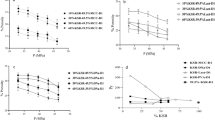Abstract
The objective of this work was to develop tablet formulations of nimesulide-β-cyclodextrin (NI-β-CD) and meloxicam-γ-cyclodextrin (ME-γ-CD) binary systems. In the case of nimesulide, 3 types of binary systems—physical mixtures, kneaded systems, and coevaporated systems—were studied. In the case of meloxicam, 2 types of binary systems—physical mixtures and kneaded systems—were investigated. Both drug-CD binary systems were prepared at 1∶1 and 1∶2 molar ratio (1∶1M and 1∶2M) and used in formulation studies. The tablet formulations containing drug-CD binary systems prepared by the wet granulation and direct compression methods showed superior dissolution properties when compared with the formulations of the corresponding pure drug formulations. Overall, the dissolution properties of tablet formulations prepared by the direct compression method were superior to those of tablets prepared by the wet granulation method. Selected tablet formulations showed good stability with regard to drug content, disintegration time, hardness, and in vitro dissolution properties over 6 months at 40°C±2°C and 75% relative humidity.
Similar content being viewed by others
References
Duchene D, Wouessidjewe D. Pharmaceutical uses of cyclodextrins and derivatives.Drug Dev Ind Pharm. 1990;16:2487–2499.
Bekers O, Uijtendal EV, Beijnen JH, Bult A, Underberg WJ. Cyclodextrins in pharmaceutical field.Drug Dev. Ind Pharm. 1991;17:1503–1549.
Davis R, Brogden RN. Nimesulide: an update of its pharmacodynamic and pharmacokinetic properties and its therapeutic efficacy.Drugs. 1994;48:431–454.
Engelhardt G, Homma D, Schlegel K, Schnitzeler C, Utzmann R. Anti inflammatory, analgesic, antipyretic and related properties of meloxicam, a new nonsteroidal anti inflammatory agent with favourable gastrointestinal tolerance.Inflamm Res. 1995;44:423–433.
Engelhardt G, Bogel R, Schnitzeler C, Utzmann R. Meloxicam: influence on arachidonic acid metabolism. Part 1: in vitro findings.Biochem Pharmacol. 1996;51:21–28.
Churchill L, Graham AG, Shih CK, Pauletti D, Farina PR, Grob PM. Selective inhibition of human cyclooxygenase-2 by meloxicam.Inflammopharmacology. 1996;4:125–135.
Pairet M, Engelhardt G. Differential inhibition of COX-1 and COX-2 in vitro and pharmacological profile in vivo of NSAIDs. In: Vane J, Botting J, Botting R, eds.Improved Nonsteroidal Anti-inflammatory Drugs-COX-2 Enzyme Inhibitors. Dordrecht, The Netherlands: Kluwer Academic Publishers; 1996:103–119.
Distel M, Mueller C, Bluhmki E. Global analysis of gastrointestinal safety of a new NSAID, meloxicam.Inflammopharmacology. 1996;4:71–81.
Turck D, Busch U, Heinzel G, Narjes H. Clinical pharmacokinetics of meloxicam.Arzneimittelforschung. 1997;47:253–258.
Piel G, Pirotte B, Delneuveille I, et al. Study of the influence of both cyclodextrins and L-lysine on the aqueous solubility of nimesulide; isolation and characterization of nimesulide-L-lysine-cyclodextrin complexes.J Pharm Sci. 1997;86:475–480.
Nalluri BN, Chowdary KPR, Murthy KV, Hayman AR, Becket G. Physicochemical characterization and dissolution properties of nimesulide-cyclodextrin binary systems.AAPS PharmSciTech. 2003;4:E2. serial online.
Naidu NB, Chowdary KP, Murthy KV, Satyanarayana V, Hayman AR, Becket G. Physicochemical characterization and dissolution properties of meloxicam-cyclodextrin binary systems.J Pharm Biomed Anal. 2004;35:75–86.
Bodmeier R, Paerataku O. Constant potassium chloride release from microporous membrane-coated tablets prepared with aqueous colloidal polymer dispersions.Pharm Res. 1991;8:355–359.
Khan KA. The concept of dissolution efficiency.J Pharm Pharmacol. 1975;27:48–49.
Carstensen JT. Stability and dating of solid dosage forms. In: Carstensen JT, ed.Pharmaceutics of Solids and Solid Dosage Forms. New York, NY: Wiley-Interscience; 1997:182–185.
Author information
Authors and Affiliations
Corresponding author
Additional information
Published: May 11, 2007
Rights and permissions
About this article
Cite this article
Nalluri, B.N., Chowdary, K.P.R., Murthy, K.V.R. et al. Tablet formulation studies on nimesulide and meloxicam-cyclodextrin binary systems. AAPS PharmSciTech 8, 36 (2007). https://doi.org/10.1208/pt0802036
Received:
Accepted:
DOI: https://doi.org/10.1208/pt0802036




